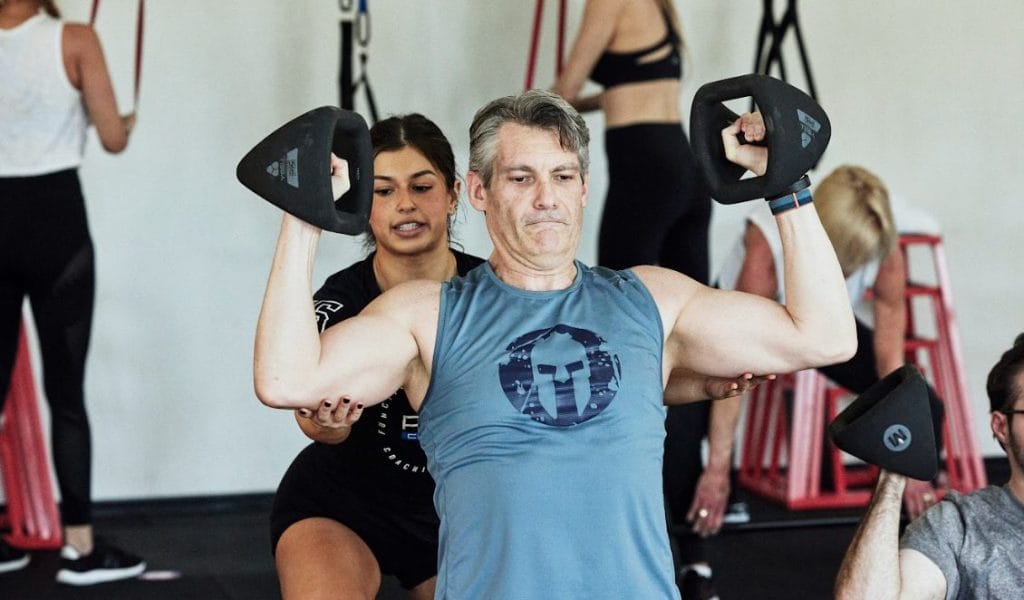As we age, maintaining muscle mass becomes increasingly important for overall health and functional strength. Contrary to popular belief, building muscle after 60 is entirely possible with the right approach. While the body undergoes changes with age, incorporating strength training into your routine can significantly improve muscle mass, strength, and overall quality of life. Here, we’ll dive into essential tips for maintaining and building muscle after 60, all centered around the core principles of strength training.
How muscle changes as we age
Sarcopenia is the natural loss of muscle mass that occurs as we get older, and this affects everyone to varying degrees. Muscle strength gradually decreases from 30 to 50, with accelerated decrease coming after 60.¹ Reduced muscle mass can have serious impacts on your functional strength – aka how easily you can carry out everyday movements, your range of motion and balance.
But research indicates that age-related muscle degradation isn’t actually inevitable and can be influenced your level of physical activity.² Whether you were previously very active or led a mostly sedentary lifestyle, continuing a consistent workout regimen can become harder with age as aches and pains evolve and muscles grow more easily fatigued. Don’t be deterred: muscle gain after 60 is more than possible and doesn’t have to strain your body or lifestyle.
How to maintain and gain muscle after 60
Building muscle after 50, 60 or 70 is different to doing it in your 20s – that much goes without saying. But it’s never too late to start or pick up your muscle-building workout regimen where you left off. There are a few ways to ease into your journey to gain muscle after 60, including resistance training, leading a balanced lifestyle and incorporating low–impact exercises. Consistency and frequency are also a factor, with the Centres for Disease Control and Prevention recommending 150 minutes of medium intensity exercise per week, including activities that build muscle mass.³ Read on for our top advice to get you started.
Start slow, progress consistently
It’s crucial to begin any new strength training regimen gradually when building muscle after 60, especially for those new to exercise or returning after a hiatus. Start with lighter weights and fewer repetitions to allow your muscles, tendons, and joints to adapt. Progressively increase the intensity, weight, or resistance as your strength improves, aiming for a challenging but manageable workload. Consistency is key: building and maintaining muscle mass is a gradual process that requires dedication and regular habits. Set realistic goals and stick to your training schedule, knowing that results will come with time and persistence.
Prioritise resistance training
Whether you’re working with free weights, resistance bands or machines, resistance training stimulates muscle growth by causing microscopic damage to muscle fibres, which then repair and grow stronger during rest. Resistance training has been seen to have positive effects on risk factors for various diseases and to help treat sarcopenia.4
To gain muscle after 50 and experience resistance training benefits, aim for at least two to three sessions per week, targeting all major muscle groups. Don’t underestimate the effectiveness of bodyweight exercises, especially for beginners or those with limited access to equipment. Push-ups, lunges, planks, and bodyweight squats can be tailored to any fitness level and are excellent for building muscle endurance and strength.
If you’re new to resistance and strength training or have specific health concerns, consider working with a fitness trainer or physical therapist. They can help design a personalised program tailored to your abilities and goals while ensuring proper form to prevent injuries. At F45, you can experience personal training in a group environment with coaches who will guide you every step of the way.
Maintain consistency outside of the gym
Alongside a sustainable fitness regimen, remember to get enough sleep; adequate rest is crucial for muscle growth and repair, especially as we age. Sleep is the time when the body does most of its repairing and rebuilding. Additionally, allow for recovery days between intense workouts to prevent overtraining and injury.
A balanced diet rich in protein is essential for muscle maintenance and growth, so aim for high-quality protein sources such as lean meats, fish, eggs, dairy, legumes and tofu. Protein intake of around 1.2 to 2.0 grams per kilogram of body weight per day is generally recommended for older adults engaging in strength training.5
Lastly, proper hydration is often overlooked but is crucial for overall health and muscle function. Dehydration can impair performance and recovery, so aim to drink plenty of water throughout the day, especially before and after workouts.
Age should never be a barrier to strength training and building muscle mass. With the right approach, individuals over 60 can learn how to build muscle and improve strength, function, and overall quality of life. By following these tips, you’ll be on your way to a stronger, healthier, and more resilient body well into your golden years. Find an F45 studio near you to put your newfound tips into practice.
1 https://pubmed.ncbi.nlm.nih.gov/17880359/
2 https://www.betterhealth.vic.gov.au/health/conditionsandtreatments/ageing-muscles-bones-and-joints
3 https://www.cdc.gov/physicalactivity/basics/older_adults/index.htm
4 https://www.ncbi.nlm.nih.gov/pmc/articles/PMC3117172/
5 https://pubmed.ncbi.nlm.nih.gov/26797090/















